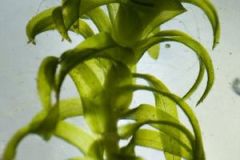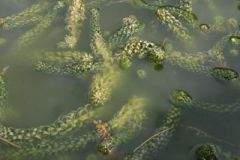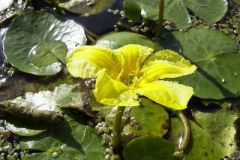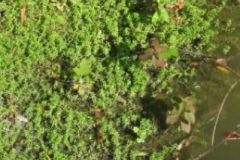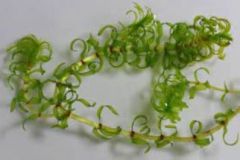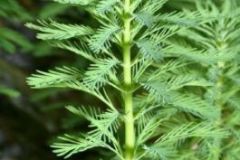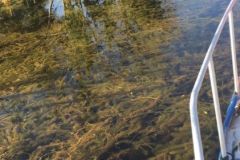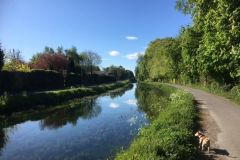Submerged Invasive Aquatic plants have found an ideal home on the still waters of Ireland’s Canals. There have been sightings on the Barrow Line, Grand, Naas and Royal Canals, and on the River Barrow.
Species
The species sighted so far are:
- New Zealand Pigmyweed (Crassula helmsii)
- Canadian Pondweed (Elodea canadensis)
- Nuttall’s Waterweed (Elodea nuttallii)
- Curly Leaved Waterweed (Lagarosiphon major)
- Parrots Feather (Myriophyllum aquaticum)
- Fringed Water-lily (Nymphoides peltata)
There have been sightings of all of these plants in our canals, but the two invasive plants that appear to be the most rampant, are the Elodeas – Canadian Pondweed (Elodea canadensis) and Nuttall’s Waterweed (Elodea nuttallii).
Growth Pattern
These plants grow throughout the warm months, from April to September, die back with the first frost, and reappear the following year when the water starts to warm up again.
Some proliferate when cut, creating new plants in the area where they were cut. They spread on the surface when pieces from the mounds left on the bank after mechanical cutting, fall back into the water and are moved along the canal when the water is released (racked) at the locks. They create new plants when pieces caught on fishing lines are thrown back into the water. And they spread further afield, when they wrap around the propellors on boats and are then carried to new areas. In the last few years, the growth on our canals has increased tremendously. In 2012 Waterways Ireland published Waterways & Diversity in which they mention just two invasive plant species, today we believe that number might be as high as six.
Damage
They prevent the use of canals as an amenity for anglers, kayakers and boating tourists.
They are harmful to coarse fishing. The rampant and impenetrable growth of these plants upsets the ecological niche, where large fish are unable to feed on small fish, resulting in large numbers of undersized fish.
They either prevent boaters from moving along the canal or result in stop and go journeys. In order to proceed, boaters have to access the water to remove weed from the propellor. In severe cases, weed wrapped around the propellor causes damage to the connections to the gear box, engine and to the engine mounts.
The silt created by the dying plants creates small and large alluvial islands. These can be seen on the Barrow Navigation where islands and reed beds are spreading and occupying space previously used to hold the water. In severe cases, this can lead to flooding when the water has nowhere to go.
Purchase
These plants are sold as oxygenators for ponds, by Garden Centres. Because of their rapid growth, they need to be thinned out regularly. Through this process, they have escaped into the wild. Even today with all that is known about these plants, Pondweed and Waterweed are still being advertised by garden centres in Ireland.
Possible Solutions
The best way to solve the spread of invasive weed in our waterways, is to prevent them arriving in the first place; therefore, they should be banned immediately. However, with already extensive growth in gardens and waterways throughout Ireland, we need to come up with a solution to eradicate them in the wild and prevent their propagation in the future.
Cutting the weed using mechanical cutters, is not a solution. In fact, it has the opposite effect because it results in new growth.
In the past, sections of the canal have been drained, and the weed killed by spraying. Once it had died back, the water was returned to the section. This is no longer an option as the spraying of this chemical has been banned due to their detrimental effect on humans, flora and fauna.
Draining the canal, a section at a time to remove the silt and puddle clay lining (a natural homogenous material) and replacing the lining with new clay, would probably work. However, with 336 kilometres of canal on the Grand, Naas/Corbally and Royal, plus the canalised portions of the River Barrow, this would be a time-consuming operation and a very expensive one.
Replacing the fleet of mechanical weed cutters with mechanical weed pullers, appears to be an option. Weed pullers remove the plants by their roots. It looks like this method has been successful on other waters. Further investigation into this mechanical solution is needed.
Future
Educating people on the long-term harm to water quality, fish and the canal amenity will be needed.
When a solution is in place, it will be imperative to have a means of assessing the results and dealing with any re-growth before it is widespread.
Invasive plants in our navigations is documented in more depth in the Nav-Watch Report
Sightings can be reported at Nav-Watch, Record Biodiversity Sightings and Tell Waterways Ireland
To record your sightings while on the move, Biodiversity Ireland created a data capture App for your phone. Details available at Biodiversity Data Capture App


